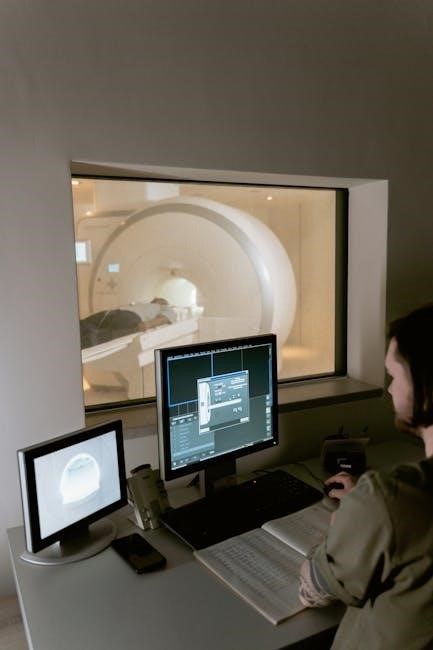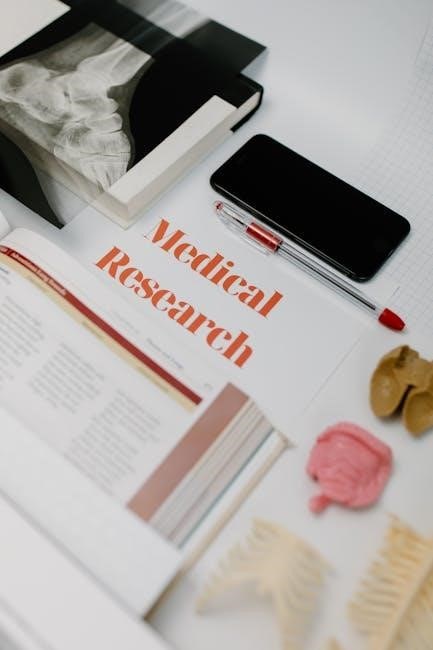This manual provides a comprehensive guide to human anatomy through cat dissections‚ offering 30 exercises with full-color illustrations and clear instructions for a hands-on learning experience.
1.1 Overview of the Manual and Its Importance
The Human Anatomy Laboratory Manual with Cat Dissections is a comprehensive guide designed to enhance understanding of human anatomy through hands-on dissection exercises. Written by Elaine N. Marieb‚ this ninth-edition manual features 30 detailed exercises covering all body systems. It includes full-color illustrations‚ visual summary tables‚ and clear instructions‚ making it an essential resource for students. The manual emphasizes practical learning‚ providing a structured approach to anatomical study. Its importance lies in bridging theoretical knowledge with real-world application‚ preparing students for future medical and scientific careers.
1.2 Benefits of Using Cat Dissections in Anatomy Studies
Cat dissections provide a practical and effective method for studying human anatomy due to their anatomical similarities to humans. These exercises offer hands-on experience‚ enhancing comprehension of complex structures. The manual’s step-by-step guidance ensures students can identify and explore body systems like the skeletal‚ muscular‚ and nervous systems; Additionally‚ cat dissections are ethically sourced and cost-effective‚ making them a widely accepted tool in medical education; This approach fosters critical thinking and prepares students for professional applications in healthcare and research.
1.3 Key Features of the Manual (Full-Color Illustrations‚ 30 Exercises‚ etc.)
The manual features 30 comprehensive exercises covering all body systems‚ each designed to enhance anatomical understanding. Full-color illustrations and detailed photographs provide visual clarity‚ aiding in the identification of structures. Clear‚ concise instructions guide students through dissections‚ while visual summary tables simplify complex concepts. The engaging writing style and organized layout ensure an accessible learning experience‚ making it an essential tool for anatomy students. These features collectively foster a deep understanding of human anatomy through practical application.

Preparation for Cat Dissection
Preparation involves gathering essential tools‚ following strict safety protocols‚ and understanding ethical considerations to ensure a respectful and safe learning experience during dissection.
2.1 Essential Tools and Equipment Needed
The dissection process requires specific tools‚ including scalpels‚ forceps‚ dissecting scissors‚ and trays. Protective gear like gloves and goggles is mandatory for safety. A well-lit workspace and proper instruments ensure precise dissection. Additionally‚ anatomical charts and manuals guide students through the process. Proper organization of tools prevents delays and enhances efficiency‚ making preparedness crucial for a successful laboratory experience.
2.2 Safety Guidelines and Laboratory Protocols
Adhering to safety guidelines is critical during dissections. Students must wear gloves‚ goggles‚ and lab coats to protect against biological exposure. Sharp instruments should be handled with care‚ and cuts should be reported immediately. Proper ventilation is essential to avoid inhaling formaldehyde fumes. Disposal of tissues and waste must follow biohazard protocols. Handwashing before and after dissection is mandatory. Emergency procedures‚ such as eye wash stations and first aid kits‚ should be accessible. Following these protocols ensures a safe and efficient laboratory environment.
2.3 Ethical Considerations in Dissection Practices
Ethical considerations in dissection practices emphasize respect for specimens and responsible use of animals in education. Students must adhere to institutional guidelines and laws governing anatomical studies. Proper handling and disposal of tissues‚ ensuring biohazardous waste protocols are followed‚ are crucial. These practices uphold the integrity of anatomical education while promoting a professional and respectful learning environment.

External Anatomy of the Cat
Identifying external landmarks and body regions‚ including fur texture‚ ear structure‚ and limb anatomy‚ aids in understanding feline morphology for comparative human anatomy studies.
3.1 Identifying External Landmarks and Body Regions
Identifying external landmarks and body regions is crucial for understanding feline anatomy. Key features include fur texture‚ ear structure‚ and limb anatomy. The ventral surface‚ including the abdomen‚ and dorsal surface‚ including the spine‚ are primary regions to identify. Students learn to distinguish between male and female cats by examining the genital area. This exercise helps in developing observational skills and provides a foundation for comparative human anatomy studies. Detailed illustrations and step-by-step instructions guide learners in accurately identifying these features.
3.2 Gender Identification and External Genitalia
Gender identification in cats is determined by examining the external genitalia. Males typically have a scrotum and a prepuce‚ while females exhibit a vulva. The anogenital distance is longer in males. To distinguish‚ locate the genital area on the ventral surface near the anus. Males have a rounded genital papilla‚ whereas females display a slit-like structure. This exercise aids in understanding sexual dimorphism‚ which is crucial for comparative anatomy studies and applies to human anatomy by highlighting similar gender-based anatomical differences. Accurate identification enhances comprehension of reproductive systems in both species.

Internal Anatomy and Body Systems
This section explores the internal structures and systems of the cat‚ providing a detailed comparison to human anatomy through dissection and visualization of organs and tissues.
4.1 Skeletal System: Structure and Function
The skeletal system provides structural support and protection for the body while facilitating movement. In cats‚ it comprises bones‚ cartilage‚ and joints. Through dissection‚ students identify bones such as the femur‚ humerus‚ and vertebrae. Joints like the elbow and knee demonstrate how bones articulate for movement. This system’s study reveals its role in human anatomy‚ emphasizing similarities and differences with feline structures. Detailed illustrations and exercises guide learners in understanding bone morphology and joint mechanics‚ enhancing their grasp of skeletal function in both species.
- Examines bone structure and joint types.
- Compares feline and human skeletal anatomy.

4.2 Muscular System: Major Muscle Groups and Their Roles
The muscular system in cats consists of skeletal‚ smooth‚ and cardiac muscles‚ enabling movement‚ maintaining posture‚ and facilitating bodily functions. Through dissection‚ students explore major muscle groups such as flexors and extensors‚ observing their attachments and actions. This hands-on study reveals how muscles work in pairs to produce movement‚ mirroring human anatomy. Detailed illustrations and exercises guide learners in identifying specific muscles‚ such as the biceps and triceps‚ and understanding their roles in locomotion and overall feline physiology.
- Examines skeletal muscle structure and function.
- Highlights muscle groups essential for movement.
4.3 Nervous System: Brain‚ Spinal Cord‚ and Peripheral Nerves
The cat’s nervous system is dissected to study its structural and functional components. The brain‚ protected by the cranium‚ is examined for regions like the cerebrum‚ cerebellum‚ and brainstem. The spinal cord‚ extending through the vertebral column‚ is explored for its role in transmitting nerve impulses. Peripheral nerves‚ branching from the central nervous system‚ are identified and traced to understand their sensory and motor functions. This exercise provides insights into the nervous system’s organization and its parallels to human anatomy.
- Explores the brain’s structure and regions.
- Examines the spinal cord’s role in nerve transmission.
- Identifies peripheral nerves and their functions.
4.4 Circulatory System: Heart‚ Blood Vessels‚ and Blood Flow
The circulatory system is examined through the dissection of the cat’s heart and blood vessels. The heart is studied for its chambers (atria and ventricles) and their roles in blood circulation. Blood vessels‚ including arteries‚ veins‚ and capillaries‚ are identified and their functions in transporting oxygenated and deoxygenated blood are explored. Observing blood flow patterns helps students understand the system’s efficiency and its relevance to human anatomy.
- Examines the heart’s structure and blood-pumping mechanism.
- Identifies arteries‚ veins‚ and capillaries and their roles.
- Studies blood flow dynamics and their importance.
4.5 Respiratory System: Lungs‚ Trachea‚ and Diaphragm
The respiratory system is explored through the dissection of the cat’s lungs‚ trachea‚ and diaphragm. The trachea‚ a cartilage-supported airway‚ leads to bronchi and finally the lungs. The diaphragm‚ a dome-shaped muscle‚ is observed for its role in expanding the chest cavity during inhalation. Students learn how air flows through these structures and how gas exchange occurs in the lungs. This exercise highlights the anatomical and functional similarities between feline and human respiratory systems‚ offering practical insights into breathing mechanisms.
- Examines the trachea’s structure and its role in air passage.
- Investigates the diaphragm’s function in breathing;
- Studies the lungs’ structure and gas exchange processes.
4.6 Urinary System: Kidneys‚ Ureters‚ and Bladder
The urinary system is examined through the dissection of the cat’s kidneys‚ ureters‚ and bladder. The kidneys‚ located near the spine‚ filter blood to produce urine‚ which travels through the ureters to the bladder for storage. The bladder is a muscular sac that expands to hold urine and contracts during urination. This section highlights the anatomical structures and their roles in waste removal‚ comparing feline and human systems to enhance understanding of urinary physiology and function.
- Explores kidney structure and filtration processes.
- Examines the ureters’ role in transporting urine.
- Studies the bladder’s storage and expulsion mechanisms.
4.7 Endocrine System: Pancreas‚ Thyroid‚ and Adrenal Glands
The endocrine system is explored through the dissection of the cat’s pancreas‚ thyroid‚ and adrenal glands. The pancreas‚ located near the stomach‚ produces hormones like insulin and glucagon to regulate blood sugar. The thyroid gland‚ situated in the neck‚ modulates metabolism‚ while the adrenal glands‚ atop the kidneys‚ produce hormones like adrenaline and cortisol. This section provides detailed insights into the structure and function of these glands‚ highlighting their roles in hormone production and overall physiological balance.
- Examines the pancreas’s role in glucose regulation.
- Explores thyroid function in metabolism and growth;
- Studies adrenal glands’ responses to stress and homeostasis.

Special Senses and Organs
This section explores the anatomy of special senses‚ focusing on the eye and ear‚ through detailed dissections and comparisons to human sensory organs‚ providing insights into their structure and function.
5.1 Eye and Ear Anatomy: Comparative Study
The manual provides detailed exercises for comparing the anatomy of the eye and ear in cats and humans. Students examine the external and internal structures‚ such as the cornea‚ retina‚ and cochlea‚ to understand their functions. Full-color illustrations and step-by-step dissections guide learners in identifying key features. This comparative approach enhances understanding of sensory systems‚ emphasizing similarities and differences between species. Practical observations and visual aids help students grasp the intricacies of vision and hearing‚ reinforcing theoretical knowledge with hands-on exploration.

Reproductive and Digestive Systems
This section explores the anatomy of the reproductive and digestive systems through detailed dissections and illustrations‚ providing a comparative understanding of their structures and functions in cats.
6.1 Reproductive System: Male and Female Anatomy
In this exercise‚ students examine the reproductive systems of both male and female cats. The male reproductive system includes the testes‚ epididymis‚ vas deferens‚ and penis‚ while the female system comprises the ovaries‚ uterus‚ and vagina. Detailed dissections allow for a comparative study of anatomical structures‚ highlighting similarities and differences. Full-color illustrations and photographs guide students through identifying key organs and their functions‚ such as sperm production in males and ovulation in females. This hands-on approach enhances understanding of reproductive biology and its role in feline anatomy. Clear instructions ensure precise dissection techniques are applied throughout the exercise. The visual aids provided in the manual further facilitate comprehension of complex structures‚ making the learning experience both engaging and effective. By exploring both systems‚ students gain a comprehensive understanding of reproductive anatomy and its functional significance in cats. This section is essential for developing a strong foundation in comparative anatomy‚ preparing students for advanced studies in human anatomy and related fields. The manual’s step-by-step instructions and detailed visuals ensure that students can confidently identify and understand the male and female reproductive systems‚ fostering a deeper appreciation for the intricacies of biological systems. Through this exercise‚ students also learn about the ethical considerations involved in dissection practices‚ emphasizing respect for anatomical specimens and the importance of responsible laboratory protocols. The combination of practical dissection‚ visual aids‚ and clear explanations makes this section a valuable resource for anatomy education. Overall‚ the reproductive system exercise provides a thorough and immersive learning experience‚ aligning with the manual’s goal of providing a comprehensive understanding of feline anatomy and its relevance to human anatomy studies. The exercise also encourages critical thinking and scientific inquiry‚ as students are prompted to compare and contrast the anatomical features of male and female reproductive systems‚ fostering a deeper understanding of biological diversity and function. This comparative approach is a hallmark of the manual’s educational philosophy‚ ensuring that students develop a well-rounded knowledge of anatomy through hands-on exploration and detailed analysis. The reproductive system section is thus a cornerstone of the manual‚ offering students the opportunity to engage with complex biological concepts in a structured and supportive learning environment. By mastering the anatomy of the reproductive systems‚ students build a solid foundation for understanding human anatomy‚ as many principles and structures are analogous. The manual’s emphasis on both male and female anatomy ensures that students gain a complete understanding of reproductive biology‚ preparing them for further studies in medicine‚ biology‚ and related disciplines. The inclusion of ethical considerations and laboratory protocols further enriches the learning experience‚ instilling in students a sense of responsibility and respect for the specimens they study. This comprehensive approach to teaching anatomy ensures that students not only gain knowledge but also develop essential skills in dissection‚ observation‚ and critical thinking‚ all of which are vital for success in scientific and medical careers. The reproductive system exercise is thus a pivotal component of the manual‚ offering students a unique opportunity to explore the intricacies of biological systems through hands-on dissection and detailed analysis. By focusing on both male and female anatomy‚ the manual provides a holistic understanding of reproductive biology‚ ensuring that students are well-prepared for advanced studies and professional applications. The combination of detailed illustrations‚ clear instructions‚ and ethical considerations makes this section an invaluable resource for anatomy education‚ aligning with the manual’s broader goals of fostering scientific literacy and anatomical expertise. Through this exercise‚ students not only learn about the structures of the reproductive systems but also gain insight into their functions and significance within the broader context of biological systems. This integrative approach to learning anatomy ensures that students develop a deep understanding of how different systems interact and contribute to overall bodily functions‚ a key principle in both feline and human anatomy. The reproductive system exercise is thus a testament to the manual’s commitment to providing a comprehensive and engaging learning experience‚ equipping students with the knowledge and skills necessary for success in their academic and professional pursuits. By emphasizing both the anatomical details and the ethical dimensions of dissection‚ the manual ensures that students approach their studies with both intellectual curiosity and a sense of responsibility‚ fostering a well-rounded and compassionate approach to scientific inquiry. This exercise‚ like others in the manual‚ is designed to promote active learning‚ encouraging students to engage directly with anatomical specimens and apply theoretical knowledge in a practical context. The result is a profound understanding of the reproductive systems‚ as well as the development of essential skills in dissection‚ observation‚ and critical thinking. These skills are not only valuable for anatomy studies but also transferable to a wide range of scientific and medical disciplines‚ ensuring that students are well-prepared for their future careers. The manual’s focus on both male and female anatomy‚ combined with its emphasis on ethical practices and laboratory protocols‚ creates a learning environment that is both challenging and supportive‚ allowing students to thrive as they explore the complexities of biological systems. Through the reproductive system exercise‚ students gain a nuanced understanding of the anatomical and functional differences between male and female reproductive systems‚ as well as the ethical considerations involved in studying these systems. This exercise is thus a cornerstone of the manual’s educational approach‚ offering students a comprehensive and immersive learning experience that aligns with the broader goals of anatomy education. By providing detailed visual aids‚ clear instructions‚ and a focus on ethical practices‚ the manual ensures that students are able to engage deeply with the material‚ developing a strong foundation in anatomy that will serve them well in their academic and professional endeavors. The reproductive system exercise is a prime example of the manual’s commitment to excellence in anatomy education‚ offering students the opportunity to explore complex biological concepts through hands-on dissection and detailed analysis. This approach not only enhances students’ understanding of feline anatomy but also provides a valuable framework for studying human anatomy‚ as many of the principles and structures are analogous. The manual’s emphasis on both male and female anatomy ensures that students gain a complete and well-rounded understanding of reproductive biology‚ preparing them for advanced studies and professional applications in fields such as medicine‚ biology‚ and health sciences. The inclusion of ethical considerations and laboratory protocols further enriches the learning experience‚ instilling in students a sense of responsibility and respect for the specimens they study. This comprehensive approach to teaching anatomy ensures that students not only gain knowledge but also develop essential skills in dissection‚ observation‚ and critical thinking‚ all of which are vital for success in scientific and medical careers. The reproductive system exercise is thus a pivotal component of the manual‚ offering students a unique opportunity to explore the intricacies of biological systems through hands-on dissection and detailed analysis. By focusing on both male and female anatomy‚ the manual provides a holistic understanding of reproductive biology‚ ensuring that students are well-prepared for advanced studies and professional applications. The combination of detailed illustrations‚ clear instructions‚ and ethical considerations makes this section an invaluable resource for anatomy education‚ aligning with the manual’s broader goals of fostering scientific literacy and anatomical expertise. Through this exercise‚ students not only learn about the structures of the reproductive systems but also gain insight into their functions and significance within the broader context of biological systems. This integrative approach to learning anatomy ensures that students develop a deep understanding of how different systems interact and contribute to overall bodily functions‚ a key principle in both feline and human anatomy. The reproductive system exercise is thus a testament to the manual’s commitment to providing a comprehensive and engaging learning experience‚ equipping students with the knowledge and skills necessary for success in their academic and professional pursuits. By emphasizing both the anatomical details and the ethical dimensions of dissection‚ the manual ensures that students approach their studies with both intellectual curiosity and a sense of responsibility‚ fostering a well-rounded and compassionate approach to scientific inquiry. This exercise‚ like others in the manual‚ is designed to promote active learning‚ encouraging students to engage directly with anatomical specimens and apply theoretical knowledge in a practical context. The result is a profound understanding of the reproductive systems‚ as well as the development of essential skills in dissection‚ observation‚ and critical thinking. These skills are not only valuable for anatomy studies but also transferable to a wide range of scientific and medical disciplines‚ ensuring that students are well-prepared for their future careers. The manual’s focus on both male and female anatomy‚ combined with its emphasis on ethical practices and laboratory protocols‚ creates a learning environment that is both challenging and supportive‚ allowing students to thrive as they explore the complexities of biological systems. Through the reproductive system exercise‚ students gain a nuanced understanding of the anatomical and functional differences between male and female reproductive systems‚ as well as the ethical considerations involved in studying these systems. This exercise is thus a cornerstone of the manual’s educational approach‚ offering students a comprehensive and immersive learning experience that aligns with the broader goals of anatomy
6.2 Digestive System: Mouth‚ Esophagus‚ Stomach‚ and Intestines
This exercise explores the digestive system of cats‚ focusing on the mouth‚ esophagus‚ stomach‚ and intestines. Students dissect and identify key structures‚ such as teeth‚ tongue‚ and gastric glands‚ while examining the role of each in digestion. Full-color illustrations guide the dissection process‚ ensuring precise identification of organs and their functions. The manual emphasizes the importance of understanding the digestive system’s anatomy‚ as it provides insights into nutrient absorption and waste elimination. This hands-on approach helps students connect feline anatomy to human digestive processes‚ enhancing their understanding of shared physiological principles. Clear instructions and detailed visuals make this exercise both educational and engaging‚ allowing students to gain practical experience in anatomical dissection while building a strong foundation in digestive system biology. The exercise also highlights the ethical considerations of working with specimens‚ reinforcing responsible laboratory practices. By studying the digestive system‚ students develop essential skills in dissection and observation‚ which are critical for advancing their knowledge of anatomy and related scientific fields. The manual’s comprehensive coverage ensures that students leave with a thorough understanding of how the digestive system functions in cats‚ providing a valuable framework for studying human anatomy. The combination of detailed illustrations‚ step-by-step instructions‚ and ethical guidelines makes this section a key component of the laboratory manual‚ offering students a unique opportunity to explore the intricacies of the digestive system through hands-on dissection and analysis. This exercise not only deepens students’ knowledge of feline anatomy but also prepares them for further studies in human biology and medicine‚ where understanding the digestive system is essential. The manual’s emphasis on both anatomical details and functional significance ensures that students gain a well-rounded understanding of the digestive process‚ from ingestion to excretion. By focusing on the mouth‚ esophagus‚ stomach‚ and intestines‚ the exercise provides a comprehensive overview of the digestive system’s structure and function‚ making it an invaluable resource for anatomy education. The inclusion of full-color illustrations and clear instructions ensures that students can confidently identify and understand each component of the digestive system‚ fostering a deeper appreciation for the complexity of biological systems. This exercise is a testament to the manual’s commitment to providing a detailed and engaging learning experience‚ equipping students with the knowledge and skills necessary for success in their academic and professional pursuits. By emphasizing both the anatomical details and the ethical dimensions of dissection‚ the manual ensures that students approach their studies with both intellectual curiosity and a sense of responsibility‚ fostering a well-rounded and compassionate approach to scientific inquiry. This exercise‚ like others in the manual‚ is designed to promote active learning‚ encouraging students to engage directly with anatomical specimens and apply theoretical knowledge in a practical context. The result is a profound understanding of the digestive system‚ as well as the development of essential skills in dissection‚ observation‚ and critical thinking. These skills are not only valuable for anatomy studies but also transferable to a wide range of scientific and medical disciplines‚ ensuring that students are well-prepared for their future careers. The manual’s focus on the digestive system‚ combined with its emphasis on ethical practices and laboratory protocols‚ creates a learning environment that is both challenging and supportive‚ allowing students to thrive as they explore the complexities of biological systems. Through this exercise‚ students gain a nuanced understanding of the digestive system’s anatomy and function‚ as well as the ethical considerations involved in studying these systems. This exercise is thus a cornerstone of the manual’s educational approach‚ offering students a comprehensive and immersive learning experience that aligns with the broader goals of anatomy education. By providing detailed visual aids‚ clear instructions‚ and a focus on ethical practices‚ the manual ensures that students are able to engage deeply with the material‚ developing a strong foundation in anatomy that will serve them well in their academic and professional endeavors. The digestive system exercise is a prime example of the manual’s commitment to excellence in anatomy education‚ offering students the opportunity to explore complex biological concepts through hands-on dissection and detailed analysis. This approach not only enhances students’ understanding of feline anatomy but also provides a valuable framework for studying human anatomy‚ as many of the principles and structures are analogous. The manual’s emphasis on both anatomical details and functional significance ensures that students gain a complete and well-rounded understanding of the digestive system‚ preparing them for advanced studies and professional applications in fields such as medicine‚ biology‚ and health sciences. The inclusion of ethical considerations and laboratory protocols further enriches the learning experience‚ instilling in students a sense of responsibility and respect for the specimens they study. This comprehensive approach to teaching anatomy ensures that students not only gain knowledge but also develop essential skills in dissection‚ observation‚ and critical thinking‚ all of which are vital for success in scientific and medical careers. The digestive system exercise is thus a pivotal component of the manual‚ offering students a unique opportunity to explore the intricacies of biological systems through hands-on dissection and detailed analysis. By focusing on the mouth‚ esophagus‚ stomach‚ and intestines‚ the manual provides a holistic understanding of the digestive process‚ ensuring that students are well-prepared for advanced studies and professional applications. The combination of detailed illustrations‚ clear instructions‚ and ethical considerations makes this section an invaluable resource for anatomy education‚ aligning with the manual’s broader goals of fostering scientific literacy and anatomical expertise. Through this exercise‚ students not only learn about the structures of the digestive system but also gain insight into their functions and significance within the broader context of biological systems. This integrative approach to learning anatomy ensures that students develop a deep understanding of how different systems interact and contribute to overall bodily functions‚ a key principle in both feline and human anatomy. The digestive system exercise is thus a testament to the manual’s commitment to providing a comprehensive and engaging learning experience‚ equipping students with the knowledge and skills necessary for success in their academic and professional pursuits. By emphasizing both the anatomical details and the ethical dimensions of dissection‚ the manual ensures that students approach their studies with both intellectual curiosity and a sense of responsibility‚ fostering a well-rounded and compassionate approach to scientific inquiry. This exercise‚ like others in the manual‚ is designed to promote active learning‚ encouraging students to engage directly with anatomical specimens and apply theoretical knowledge in a practical context. The result is a profound understanding of the digestive system‚ as well as the development of essential skills in dissection‚ observation‚ and critical thinking. These skills are not only valuable for anatomy studies but also transferable to a wide range of scientific and medical disciplines‚ ensuring that students are well-prepared for their future careers. The manual’s focus on the digestive system‚ combined with its emphasis on ethical practices and laboratory protocols‚ creates a learning environment that is both challenging and supportive‚ allowing students to thrive as they explore the complexities of biological systems. Through this exercise‚ students gain a nuanced understanding of the digestive system’s anatomy and function‚ as well as the ethical considerations involved in studying these systems. This exercise is thus a cornerstone of the manual’s educational approach‚ offering students a comprehensive and immersive learning experience that aligns with the broader goals of anatomy education. By providing detailed visual aids‚ clear instructions‚ and a focus on ethical practices‚ the manual ensures that students are able to engage deeply with the material‚ developing a strong foundation in anatomy that will serve them well in their academic and professional endeavors. The digestive system exercise is a prime example of the manual’s commitment to excellence in anatomy education‚ offering students the opportunity to explore complex biological concepts through hands-on dissection and detailed analysis. This approach not only enhances students’ understanding of feline anatomy but also provides a valuable framework for studying human anatomy‚ as many of the principles and structures are analogous. The manual’s emphasis on both anatomical details and functional significance ensures that students gain a complete and well-rounded understanding of the digestive system‚ preparing them for advanced studies and professional applications in fields such as medicine‚ biology‚ and health sciences. The inclusion of ethical considerations and laboratory protocols further enriches the learning experience‚ instilling in students a sense of responsibility and respect for the specimens they study. This comprehensive approach to teaching anatomy ensures that students not only gain knowledge but also develop essential skills in dissection‚ observation‚ and critical thinking‚ all of which are vital for success in scientific and medical careers. The digestive system exercise is thus a pivotal component of the manual‚ offering students a unique opportunity to explore the intricacies of biological systems through hands-on dissection and detailed analysis. By focusing on the mouth‚ esophagus‚ stomach‚ and intestines‚ the manual provides a holistic understanding of the digestive process‚ ensuring that students are well-prepared for advanced studies and professional applications. The combination of detailed illustrations‚ clear instructions‚ and ethical considerations makes this section an invaluable resource for anatomy education‚ aligning with the manual’s broader goals of fostering scientific literacy and anatomical expertise. Through this exercise‚ students not only learn about the structures of the digestive system but also gain insight into their functions and significance within the broader context of biological systems. This integrative approach to learning anatomy ensures that students develop a deep understanding of how different systems interact and contribute to overall bodily functions‚ a key principle in both feline and human anatomy. The digestive system exercise is thus a testament to the manual’s commitment to providing a comprehensive and engaging learning
